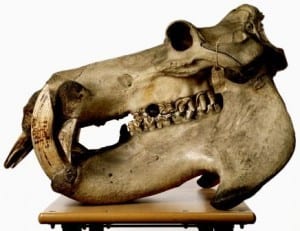Specimen of the Week: Week Twenty-Four
By Emma-Louise Nicholls, on 26 March 2012
 I am currently in Egypt trying really hard, though probably failing, to see an Egyptian vulture. Why? Look at this, you’ve got to love this face. It’s yellow for starters, and has a mega cool feather hair-do for seconds. Brilliant. I decided of course to write this week’s blog on an Egyptian specimen but it seems we are somewhat sadly lacking in that area so my specimen is a tenuous link at best. In the meantime, this week’s specimen is of a species that was found in Egypt, though is now regionally extinct in northern Africa. It was also found in Europe once upon a time, which may surprise you. This week’s specimen of the week is…
I am currently in Egypt trying really hard, though probably failing, to see an Egyptian vulture. Why? Look at this, you’ve got to love this face. It’s yellow for starters, and has a mega cool feather hair-do for seconds. Brilliant. I decided of course to write this week’s blog on an Egyptian specimen but it seems we are somewhat sadly lacking in that area so my specimen is a tenuous link at best. In the meantime, this week’s specimen is of a species that was found in Egypt, though is now regionally extinct in northern Africa. It was also found in Europe once upon a time, which may surprise you. This week’s specimen of the week is…
**!!!The Hippopotamus!!!**
1) Hippos are in the top five largest land mammals in the world alive today (the caginess is due to a lack of clarity on how many species of elephant there are, and if all of them are bigger than hippos). But despite laughing in the face of weight loss diets with their 3,200 kg bulk, underwater they are very graceful swimmers.
2) Hippos spend around 2/3rds of their day wallowing about in water. The Ancient Greeks, having observed this habit, started referring to them as ‘river horses’ which became a nickname that stuck; their scientific name is Hippopotamus amphibius .
3) Hippos mostly hang out in the shallow areas of rivers and lakes, standing on the substrate at the bottom. Evolution considerately placed their eyes and nostrils just above the water line, meaning that they can stand like this all day.
4) Hippos have been reported throughout the ages to sweat blood. Unfortunately, to the utter disappointment of vampire bats everywhere, this is not actually true. They do however secrete an oily substance through their skin that is in fact red, so you can perhaps see their confusion. It is thought that it acts as both a moisturiser and sunblock in the African heat, and may also protect against germs.
5) What do you think of great white sharks? Scary? Dangerous? Man-killers? Rubbish. More people get killed each year by coconuts. And, more contextually, hippos. They are actually responsible for more deaths each year in Africa than sharks, crocodiles, and big cats.
Sneaky fact 6) The Grant Museum of Zoology does in fact have a hippo from Egypt, albeit a fossil. So it wasn’t an entirely tenuous link now was it.
4 Responses to “Specimen of the Week: Week Twenty-Four”
- 1
- 2
 Close
Close





Coconuts are really the world’s most unfortunate ambush predators – after stunning their victims they’re too concussed themselves to ever be able to eat them.